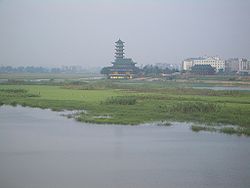Daye, Hubei
|
Daye 大冶市 |
|
|---|---|
| County-level city | |

Daye Lake on the southern edge of Daye's urban core. The Qing Long Ta ("Purple Dragon Pagoda") is in the middle.
|
|
| Location in Hubei | |
| Coordinates: 30°06′N 114°59′E / 30.100°N 114.983°ECoordinates: 30°06′N 114°59′E / 30.100°N 114.983°E | |
| Country | People's Republic of China |
| Province | Hubei |
| Prefecture-level city | Huangshi |
| Area | |
| • Total | 1,460 km2 (560 sq mi) |
| Elevation | 25 m (82 ft) |
| Population (2000) | |
| • Total | 813,600 |
| • Density | 560/km2 (1,400/sq mi) |
| Time zone | China Standard (UTC+8) |
| Website | http://www.hbdaye.gov.cn/ |
Daye (Chinese: 大冶; pinyin: Dàyě) is a city of eastern Hubei province, People's Republic of China. Administratively, it is a county-level city of Huangshi City.
Before the adoption of the Hanyu Pinyin, the name of the city was often transcribed in English as Tayeh.
As it is usually the case with county-level cities, Daye includes both an urban core and a fair amount of rural land in all directions, with smaller townships (zhen) such as Dajipu (大箕铺). According to the Fifth Population Census of China (2000), the entire county-level city of Daye had 813,600 residents, with a population density of 558 people per square kilometer.
The Daye Lake south of Daye's urban core is surrounded by parks and fishing ponds, and is a popular place for recreation.
For a traveler who goes on G316 from Wuhan toward the south-east, Daye appears as a border between the more urban and more rural parts of the province. Daye sits on the south-eastern border of the heavily industrialized Wuhan/Ezhou/Huangshi metropolitan area; south of it, the much more rural Yangxin County begins.
Daye is an industrial city, a center of mining and metallurgy, both ferrous and non-ferrous; its name means 'Big Smeltery'.
According to archaeologists, copper mining and smelting was conducted at Daye's Tonglüshan Mine (, 30°04′52″N 114°56′07″E / 30.08111°N 114.93528°E) as early as the Spring and Autumn period (6th century B.C.E.), if not earlier. Tonglüshan Mine is located just southwest of the modern city, and now has a museum.
...
Wikipedia

